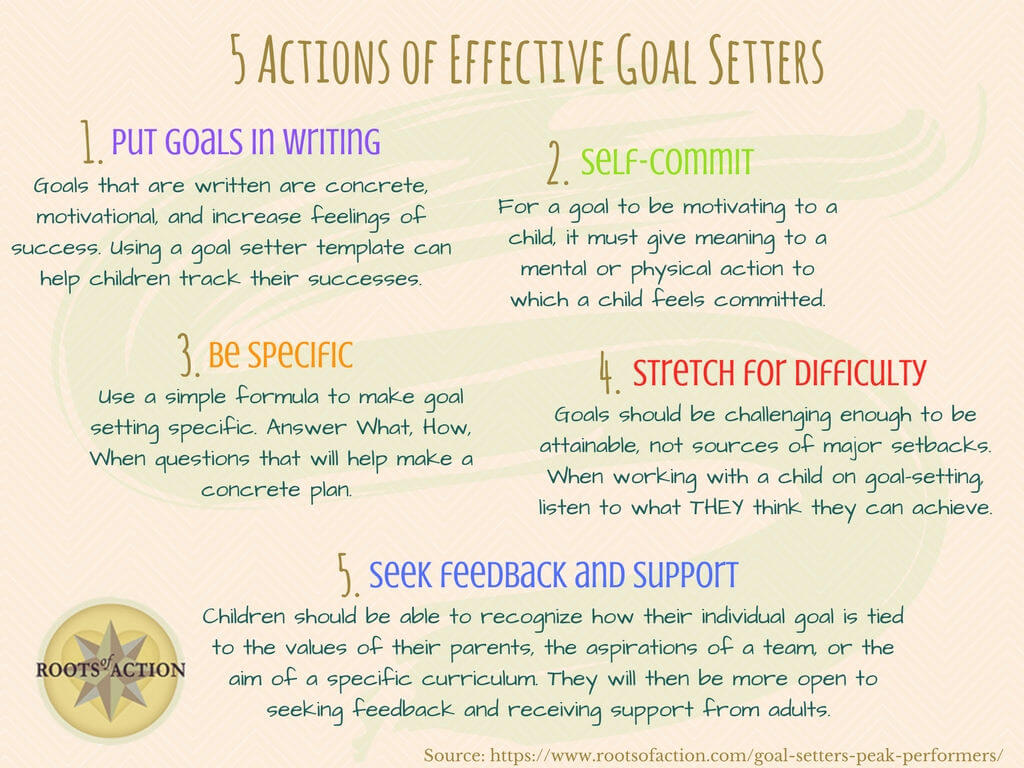
Are your children, students, or sports team players goal setters?
Did you know that goal-setting is a skill that is highly associated with those who excel in school, work, and life?
Setting goals is a common practice in the workplace; and for good reasons. Written goals provide a road map by which employees can measure their efforts and see how they contribute to the success of work teams and ultimately, to their organizations. Goals also help motivate athletes, entrepreneurs, and individuals to achieve at higher levels of difficulty.
But goal-setting isn’t just for adults. In fact, being goal-oriented is a critical part of learning to be resourceful, our ability to find and use available resources to solve problems and shape our futures. Resourcefulness is a core competency in The Compass Advantage model and key to positive youth development.
“Goal setters see future possibilities and the big picture,” says Rick McDaniel in a Huffington Post article. He discusses the important difference between being a goal setter and problem solver, the latter often getting bogged down in road blocks. “Goal setters,” he says, “are comfortable with risk, prefer innovation and are energized by change.”
There are many ways parents, teachers, and coaches help children become resourceful. One important way is to help them become goal setters. Research has uncovered many key aspects of goal setting theory and its link to success (Kleingeld, et al, 2011). Setting goals is linked with self-confidence, motivation, and autonomy (Locke & Lathan, 2006). One study showed when people wrote down their goals, they were 33% more successful in achieving them than those who formulated outcomes in their heads.
Let’s explore how to apply the research on goal-setting at home, in the classroom, or on the sports field.
Five Actions of Effective Goal Setters
Children and teens become effective goal setters when they understand and develop five action-oriented behaviors, and incorporate these actions with each goal set.
1. Put goals in writing.
Goals that are written are concrete and motivational. Making progress toward written goals increases feelings of success and well-being. Using a goal setter template can help children track their successes. A goal setter app may motivate tech-savvy children even more. Some apps have gaming features that make goal-setting a fun way to achieve results and build new habits.
2. Self-commit.
For a goal to be motivating to a child, it must give meaning to a mental or physical action to which a child feels committed. This self commitment becomes a key element in self-regulation, a child’s ability to monitor, control, and alter his own behaviors. This doesn’t mean that parents or teachers should not be involved in goal-setting. In fact, adults can serve as goal facilitators—helping kids see options, asking core questions, and providing supportive feedback.
3. Be specific.
Goals must be much more specific than raising a grade or improving performance on the soccer field. Here’s a simple formula. 1) I will [raise my grade in algebra from a C to a B]; 2) By doing what? [regular homework, and spending time with an online algebra program or game]; 3) When? How? With Whom? [increase daily algebra homework by 15 minutes to include a fun online interactive algebra practice; spend 15 fewer minutes on social media; get support from teacher/tutor for things that are not understood]; 4) Measured by [increased time spent; improved weekly test scores].
4. Stretch for difficulty.
Goals should always be challenging enough to be attainable, but not so challenging that they become sources of major setbacks. When working with a child on goal-setting, listen to what they think they can achieve rather than what you want them to achieve.
5. Seek feedback and support.
Part of the fun and motivation of setting goals is working on them in a supportive group environment. Even though goals are often individual in nature, children should be able to recognize how their goal is tied to the values of their parents, the aspirations of a sports team, or the aim of a specific curriculum. When they understand this connection, they feel more open to seeking feedback and receiving support from adults. When goals are achieved, it’s time to celebrate with others!
Goal Setters Infographic
Feel free to use and share the infographic below that outlines the five actions of effective goal setters.
Worksheets, Templates and Games to Teach Goal Setting
An article at PositivePsychology.com provides many ideas to help students become goal setters, including how children benefit from setting goals, a review of the research, and how to teach goal setting. The article includes a variety of worksheets and templates that can be used with kids at various ages. Games that involve goal setting are highlighted too, making the idea of becoming a goal setter fun.
References
Kleingeld, A., van Mierlo, H., & Arends, L. (2011). The effect of goal setting on group performance: A meta-analysis. Journal of Applied Psychology, 96(6), 1289-1304.
Locke, E. A., & Latham, G. P. (2006). New Directions in Goal-Setting Theory. Current Directions in Psychological Science, 15(5), 265-268.
(This article was originally published March 23, 2018. It was updated and republished October 29, 2019.)
Published: October 29, 2019





